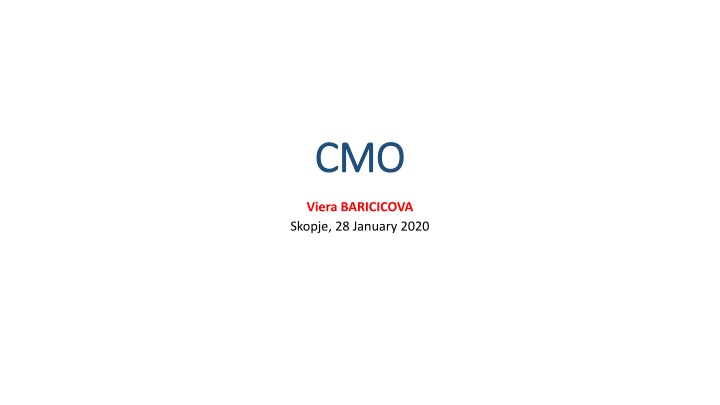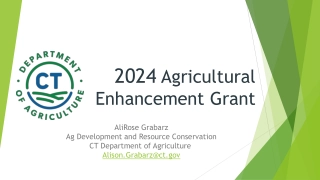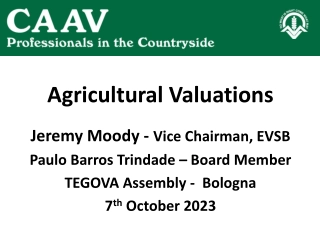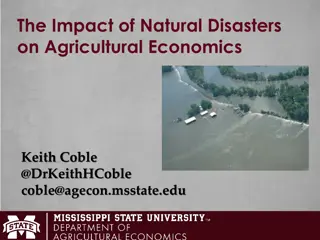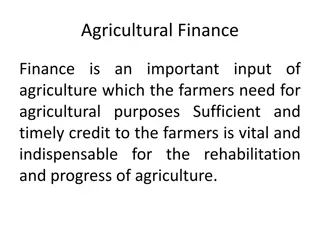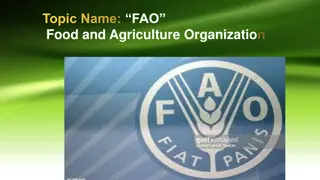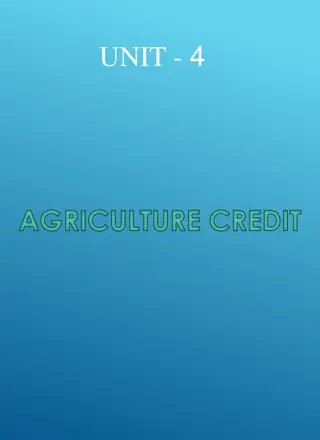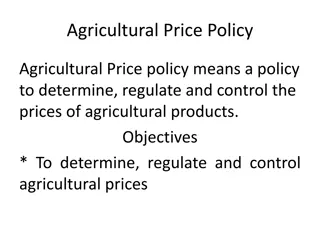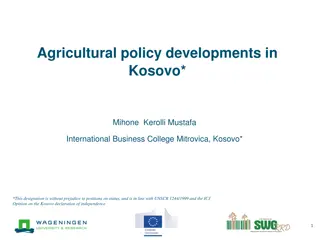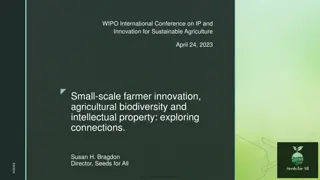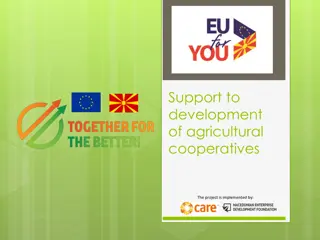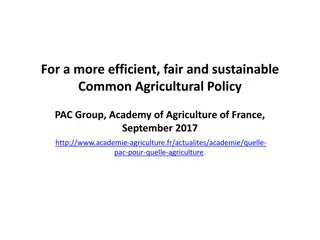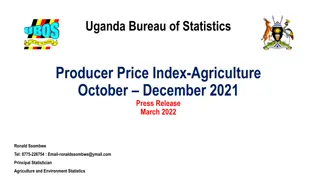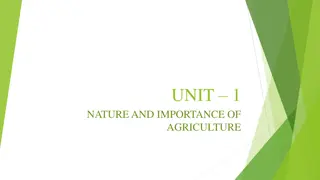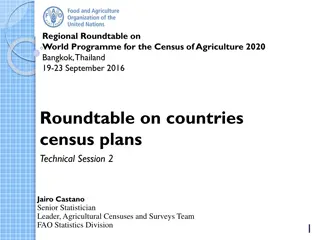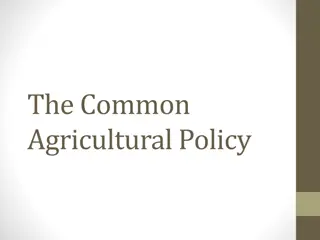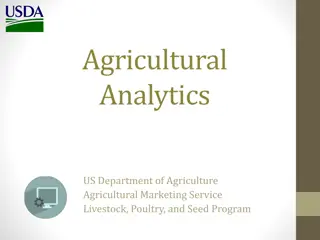Insights into Common Agricultural Policy and Market Organization
Explore the various facets of Common Agricultural Policy, including knowledge-based farming, farm viability and resilience in transitional economies, and the subjects covered under the Common Market Organization Regulation No. 1308/2013. Learn about internal market support programs in different agricultural sectors, such as wine, olive oil, and fruit and vegetables.
Uploaded on Sep 21, 2024 | 4 Views
Download Presentation

Please find below an Image/Link to download the presentation.
The content on the website is provided AS IS for your information and personal use only. It may not be sold, licensed, or shared on other websites without obtaining consent from the author.If you encounter any issues during the download, it is possible that the publisher has removed the file from their server.
You are allowed to download the files provided on this website for personal or commercial use, subject to the condition that they are used lawfully. All files are the property of their respective owners.
The content on the website is provided AS IS for your information and personal use only. It may not be sold, licensed, or shared on other websites without obtaining consent from the author.
E N D
Presentation Transcript
CMO CMO Viera BARICICOVA Skopje, 28 January 2020
Knowledge based farming Complete farm management planning, tracking and analyzing all field activities, tracking finance and monitoring real-time inventory levels. Weather monitoring & smart pest alarms Regular weather monitoring, forecast and prognosis Identification of the possible pest or disease threat on farmer s fields alarm for on-time crop protection and reduce risk of yield reduction. Powerful analytics reports and real-time dashboards support of the farming business and discover possible improvements and cost savings.
Farm viability and resilience Viability = ability to work successfully Resilience = ability to cope with changes Farms in transitional economy Co operatives heritage in post soviet countries New way of farms operation Problems remaining: - dependence on agricultural resources, - obsolete agricultural technologies, - underemployment, - lack of occupational alternatives, - low level of education - poverty
Common Market Organization Regulation (EC) No 1308/2013 What is subject of the CMO? Cereals Fruit and vegetables Sheepmeat and goatmeat Rice Processed fruit and vegetables Eggs Bananas Poultrymeat Sugar Wine Ethyl alcohol -agricultural Dried fodder Live trees and other plants Apiculture products Seeds Tobacco Silkworms Hops Beef and veal Other products Olive oil and table olives Milk and milk products Pigmeat Flax and hemp
Internal market Aid for private storage White sugar Olive oil Flax fibre Fresh or chilled meat bovine more than 8 months Butter cow milk Cheese Skimmed milk powder- cow milk Pigmeat, sheep and goatmeat Public interventions Cereals, maize Paddy rice Beef and veal Butter and skimmed milk powder
Internal market Support programmes in the wine sector 5 years national support programmes Promotion, Restructuring and conversion of vineyards Green harvesting Mutual funds Harvest insurance Investments Innovation in wine sector By-products distillation Aid schemes School fruit and vegetables scheme joined with milk scheme) Aid in the olive oil and table olives sector Greece, France, Italy) Aid in the fruit and vegetables sector ( 2017/2018
Marketing standards EC regulation 1308/2013 Art. 75 Olive oil and table olives Fruit and vegetables Processed fruit and vegetables Bananas Live plants Eggs Poultry meat Sppreadable fats for human consumption Art 80 wine sector Oenological practices and methods of analysis Art 81- wine grape varieties Art 89 marketing standards related to import and export Art 90 special provisions for the imports of wine Hops
1308/2013, art.75;3 a)the technical definitions, designation and sales descriptions for sectors other than those set out in Article 78; (b) classification criteria such as grading into classes, weight, sizing, age and category; (c) the species, plant variety or animal race or the commercial type; (d) the presentation, labelling linked to obligatory marketing standards, packaging, rules to be applied in relation to packing centers, marking, year of harvesting and use of specific terms, without prejudice to Articles 92 to 123; (e) criteria such as appearance, consistency, conformation, product characteristics and the percentage of water content; (f) specific substances used in production, or components or constituents, including their quantitative content, purity and identification;
Farmers participation in business oriented groups Legal basis: 1308/2013 art 152 - 159 Producer organisations in sectors: Fruit and vegetables - art 32 - 38 Olive oil and table olives Hops Milk
Role of the producers organisations Concentrating supply Improving the marketing Planning and adjustig of production to demand Optimising production costs Stabilising producers prices Research Best practices Risk management tools
Example fruit and vegetables sector EU Regulation (EU) No 1308/2013 establishing a common market organisation of the markets in agricultural products Commision Delegated Regulation (EU) 2017/891 fruit and vegetables and processed fruit and vegetables sectors Commission Implementing Regulation (EU) 2017/892 rules for application of 1308/2013 National Governmental regulation No. 273/2017 on conditions for implementation of certain measures for common market organisation in fruit and vegetables sector National strategy for operational programs for Producers organisations in fruit and vegetables sector National environmental framework
PO s operational programme Planning of production Quality measures Improving marketing, promotion Research and innovation Operational programme Technical assistance, training Crisis prevention and management Environmental measures Other measures
Agricultural statistics and ecomomic analysis Statistical data collection from MS / entry prices, market prices reported How are data used? Agricultural statistics Rural Development statistics Agri trade statistics https://ec.europa.eu/eurostat/web/agriculture/data/database https://ec.europa.eu/agriculture/statistics_en https://ec.europa.eu/eurostat/web/agriculture/legislation Economic analysis developed by: EU - https://ec.europa.eu/agriculture/policy-perspectives/analysis-and-reports_en OECD - https://stats.oecd.org/ FAO - http://www.fao.org/faostat/en/#home
Organic farming COUNCIL REGULATION (EC) No 834/2007 of 28 June 2007 on organic production and labelling of organic products and repealing Regulation (EEC) No 2092/91 - all stages of production, preparation and distribution ( food and feed), their control - definitions, objectives and principles (farming and processing) - Rules, GMO prohibition Basic requirements - food and feed law
ORGANIC FARMING COMMISSION REGULATION (EC) No 1235/2008 of 8 December 2008 laying down detailed rules for implementation of Council Regulation (EC) No 834/2007 as regards the arrangements for imports of organic products from third countries Detailed rules on imports of organic products to EU Approved 3rd countries ( 7) Recognized control bodies and control authorities Procedures of recognition Certification procedure
Importing organic products Organic products from non- EU countries only if produced and inspected under conditions that are identical or equivalent to those applying to EU organic producers Since 2007 new import rules Control bodies / certifying organizations operating in non EU countries possibility to be directly authorized and monitored by EC and EU member states EC can supervise and monitor import of organic products EU rules on organic produce includes wine, aquaculture products and seaweed
Wine PGI PGI: trademark attributed by the European Union to agrifood products for which a specific quality, the reputation or other characteristics depends by the geographical origin, and whose production and or processing happens in a specific geographical area. Protected Geographical Indication - origin PGI protection within EU 1579 wines and 339 spirit drinks COM Regulation (EC) No 607/2009 detailed rules on application and examination procedures Application of products originated from 3rd countries only if they fulfil the same or equivalent conditions Checks declaration to the competent authority in MS, annual verification, checks performed by competent authority
E-Bacchus" is a database which, - consists of the Register of designations of origin and geographical indications protected in the EU in accordance with Regulation (EU) No 1308/2013, - lists non-EU countries' geographical indications and names of origin protected in the EU in accordance with bilateral agreements on trade in wine concluded between the EU and the non-EU countries' concerned, - lists the traditional terms protected in the EU in accordance with Regulation (EU) No 1308/2013.
National policy in pre accession period Slovak Republic Establishing simmilar conditions to those existing in EU Producers groups in fruit and vegetables sector Inspection bodies / national authorities for control were well established in late 50 ties Quality standards were harmonized to the EU marketing standards / UNECE standards Legal conditions to allow operating / eg. Producers groups were approved after access to EU Today different situation reform of the CAP is in construction changes in many sectors Not to be focused to the recent legal framework, but follow the new rules / CAP 2021
